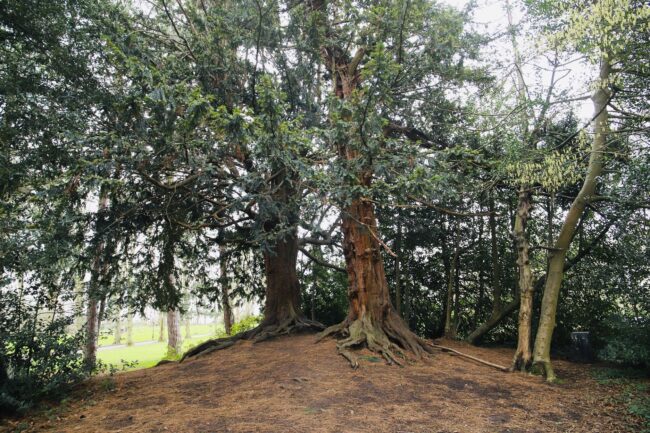Head to the Grove in Alexandra Park to discover March’s Tree of the Month. Stephen Middleton from the Friends of Alexandra Park explains further…
Hunt for these gothic trees, a pair of Common Yews (Taxus baccata), with roots seeming to rise out of the ground and dark evergreen foliage. They can be found on a mound in The Grove, in a clump of trees to the east of the Grove Cafe, and are our trees of the month.
The southernmost tree is male with its flowers producing clouds of pollen in February or March. The female tree next to it has small, insignificant flowers which, after being pollinated, will develop into red fleshy arils (berry-like fruit) towards the end of summer.
The pollen is spread to the female tree by wind, but the snotty-gogs (one of the better local names for the fruit) are mostly spread by birds.
A striking feature of our tree is the red bark with its bumps and ridges. Now look closely at the leaves, you will see that they are attached to the twig in a spiral; however they flatten out into two parallel lines.
This is definitely not a tree to snack on with nearly the whole tree highly poisonous to humans and many animals. These chemicals also help discourage plant competition close to the tree.
Some of these very poisons have been developed into medicines. The cancer drug docetaxel used to be extracted from the leaves of this tree, but is now made artificially.
This species grows slowly and is probably the longest lived of our native trees with some individuals thought to live to over 2,000 years old.

In the past it has been removed from part of the countryside to protect livestock, but now it is beginning to be found much more commonly as fewer farm animals are now to be found in our woodlands.
The traditional home to the yew are the nation’s churchyards where some of the oldest, most wizened and hollow examples can be found. Some were there before the churches and others may have been planted to remind us of our own short lives.
Yews are found in most of Europe, north Africa as well as parts of east Asia. These trees are tough; being tolerant to shade, drought, salt and even atmospheric pollution although their favoured position is in well-drained chalky soil.
The wood from our tree of the month is prized for furniture especially when it has knots in it producing elaborate patterns. It was, however, most famously used in weapons of war such as the longbow. A yew spear handle dating back about 400,000 years was found in Clacton, Essex and is believed to be the world’s oldest wooden spear.
Not everyone was keen on this tree, the Roman writer Pliny said “Neither verdant, nor graceful, but gloomy, terrible and sapless.






